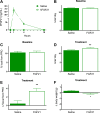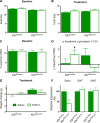Fibroblast Growth Factor-21 Controls Dietary Protein Intake in Male Mice
- PMID: 30802283
- PMCID: PMC6469953
- DOI: 10.1210/en.2018-01056
Fibroblast Growth Factor-21 Controls Dietary Protein Intake in Male Mice
Abstract
Whereas carbohydrates and lipids are stored as glycogen and fat, there is no analogous inert storage form of protein. Therefore, continuous adjustments in feeding behavior are needed to match amino acid supply to ongoing physiologic need. Neuroendocrine mechanisms facilitating this behavioral control of protein and amino acid homeostasis remain unclear. The hepatokine fibroblast growth factor-21 (FGF21) is well positioned for such a role, as it is robustly secreted in response to protein and/or amino acid deficit. In this study, we tested the hypothesis that FGF21 feeds back at its receptors in the nervous system to shift macronutrient selection toward protein. In a series of behavioral tests, we isolated the effect of FGF21 to influence consumption of protein, fat, and carbohydrate in male mice. First, we used a three-choice pure macronutrient-diet paradigm. In response to FGF21, mice increased consumption of protein while reducing carbohydrate intake, with no effect on fat intake. Next, to determine whether protein or carbohydrate was the primary-regulated nutrient, we used a sequence of two-choice experiments to isolate the effect of FGF21 on preference for each macronutrient. Sweetness was well controlled by holding sucrose constant across the diets. Under these conditions, FGF21 increased protein intake, and this was offset by reducing the consumption of either carbohydrate or fat. When protein was held constant, FGF21 had no effect on macronutrient intake. Lastly, the effect of FGF21 to increase protein intake required the presence of its co-receptor, β-klotho, in neurons. Taken together, these findings point to a novel liver→nervous system pathway underlying the regulation of dietary protein intake via FGF21.
Copyright © 2019 Endocrine Society.
Figures






Similar articles
-
Fibroblast growth factor 21 and dietary macronutrient intake in female mice.Physiol Behav. 2022 Dec 1;257:113995. doi: 10.1016/j.physbeh.2022.113995. Epub 2022 Oct 12. Physiol Behav. 2022. PMID: 36240865
-
Circulating FGF21 in humans is potently induced by short term overfeeding of carbohydrates.Mol Metab. 2016 Nov 16;6(1):22-29. doi: 10.1016/j.molmet.2016.11.001. eCollection 2017 Jan. Mol Metab. 2016. PMID: 28123934 Free PMC article.
-
Homeostatic sensing of dietary protein restriction: A case for FGF21.Front Neuroendocrinol. 2018 Oct;51:125-131. doi: 10.1016/j.yfrne.2018.06.002. Epub 2018 Jun 8. Front Neuroendocrinol. 2018. PMID: 29890191 Free PMC article. Review.
-
FGF21 and the Physiological Regulation of Macronutrient Preference.Endocrinology. 2020 Mar 1;161(3):bqaa019. doi: 10.1210/endocr/bqaa019. Endocrinology. 2020. PMID: 32047920 Free PMC article. Review.
-
Dietary protein restriction modulates 'dessert' intake after a meal, via fibroblast growth factor 21 (FGF21).Physiol Behav. 2023 Dec 1;272:114368. doi: 10.1016/j.physbeh.2023.114368. Epub 2023 Oct 5. Physiol Behav. 2023. PMID: 37805134
Cited by
-
Hepatocyte-specific fibroblast growth factor 21 overexpression ameliorates high-fat diet-induced obesity and liver steatosis in mice.Lab Invest. 2022 Mar;102(3):281-289. doi: 10.1038/s41374-021-00680-9. Epub 2021 Nov 3. Lab Invest. 2022. PMID: 34732847
-
FGF21 as a mediator of adaptive changes in food intake and macronutrient preference in response to protein restriction.Neuropharmacology. 2024 Sep 1;255:110010. doi: 10.1016/j.neuropharm.2024.110010. Epub 2024 May 24. Neuropharmacology. 2024. PMID: 38797244 Free PMC article. Review.
-
Fibroblast Growth Factor 21 Facilitates the Homeostatic Control of Feeding Behavior.J Clin Med. 2022 Jan 24;11(3):580. doi: 10.3390/jcm11030580. J Clin Med. 2022. PMID: 35160033 Free PMC article. Review.
-
The Nuanced Metabolic Functions of Endogenous FGF21 Depend on the Nature of the Stimulus, Tissue Source, and Experimental Model.Front Endocrinol (Lausanne). 2022 Jan 3;12:802541. doi: 10.3389/fendo.2021.802541. eCollection 2021. Front Endocrinol (Lausanne). 2022. PMID: 35046901 Free PMC article. Review.
-
FGF21 controls hepatic lipid metabolism via sex-dependent interorgan crosstalk.JCI Insight. 2022 Oct 10;7(19):e155848. doi: 10.1172/jci.insight.155848. JCI Insight. 2022. PMID: 35998055 Free PMC article.
References
-
- Solon-Biet SM, Cogger VC, Pulpitel T, Heblinski M, Wahl D, McMahon AC, Warren A, Durrant-Whyte J, Walters KA, Krycer JR, Ponton F, Gokarn R, Wali JA, Ruohonen K, Conigrave AD, James DE, Raubenheimer D, Morrison CD, Le Couteur DG, Simpson SJ. Defining the nutritional and metabolic context of FGF21 using the geometric framework. Cell Metab. 2016;24(4):555–565. - PubMed
-
- Solon-Biet SM, McMahon AC, Ballard JW, Ruohonen K, Wu LE, Cogger VC, Warren A, Huang X, Pichaud N, Melvin RG, Gokarn R, Khalil M, Turner N, Cooney GJ, Sinclair DA, Raubenheimer D, Le Couteur DG, Simpson SJ. The ratio of macronutrients, not caloric intake, dictates cardiometabolic health, aging, and longevity in ad libitum-fed mice. Cell Metab. 2014;19(3):418–430. - PMC - PubMed
-
- Nishimura T, Nakatake Y, Konishi M, Itoh N. Identification of a novel FGF, FGF-21, preferentially expressed in the liver. Biochim Biophys Acta. 2000;1492(1):203–206. - PubMed
-
- Kharitonenkov A, Shiyanova TL, Koester A, Ford AM, Micanovic R, Galbreath EJ, Sandusky GE, Hammond LJ, Moyers JS, Owens RA, Gromada J, Brozinick JT, Hawkins ED, Wroblewski VJ, Li DS, Mehrbod F, Jaskunas SR, Shanafelt AB. FGF-21 as a novel metabolic regulator. J Clin Invest. 2005;115(6):1627–1635. - PMC - PubMed
Publication types
MeSH terms
Substances
Grants and funding
LinkOut - more resources
Full Text Sources
Medical
Molecular Biology Databases

